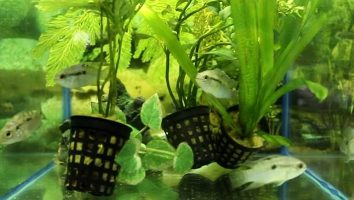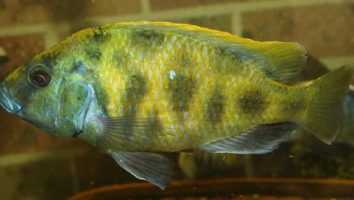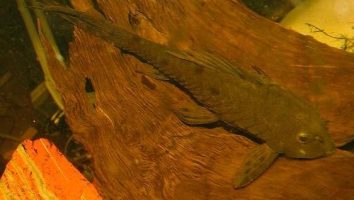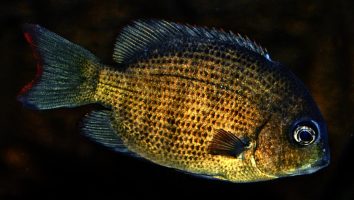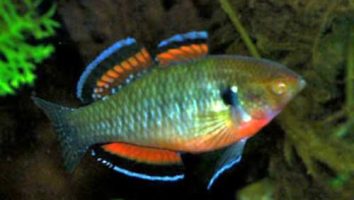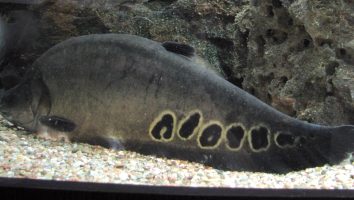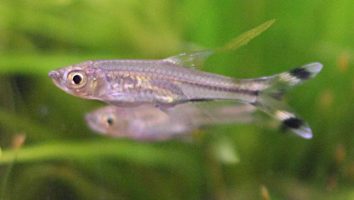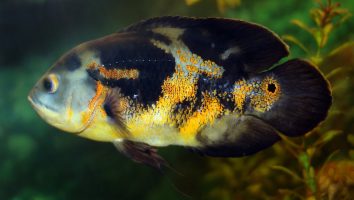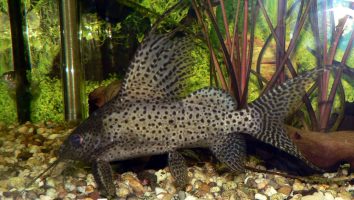The fire eel is a stunning freshwater fish that can add a lot of personality to your tank.
This species is relatively easy to care for, but there are a few things you need to know before you get one.
In this guide, we’ll teach you everything you need to know about fire eel care. You’ll learn about their diet, size, lifespan, and more!
Table of contents
Species overview
The fire eel (scientific name: Mastacembelus erythrotaenia) is a type of freshwater eel that’s native to Southeast Asia. In the wild, they can be found in countries such as Cambodia, Laos, Thailand, and Vietnam.
These eels prefer slow-moving water with a lot of vegetation. This is something that’s common among many types of eel, as they like to have plenty of places to hide.
Fire eels are some of the largest freshwater eels out there and can grow to be over 6 feet long! In the aquarium, however, they will typically only grow to be about 3-4 feet in length.
Due to their size and aggression, fire eels are not recommended for beginner aquarists. They should only be kept by experienced fishkeepers who are comfortable dealing with large, aggressive fish.
Appearance
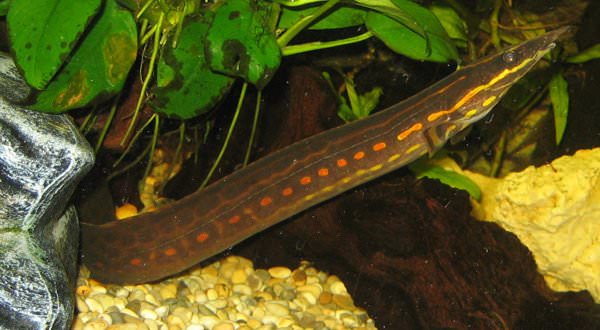
The first thing you’ll notice about the Fire eel is their long, snake-like body. These eels can get quite large, with some specimens reaching up to 6 feet in length!
They have a slender build that’s covered in smooth scales. The coloration of this fish is where they get their name. The base color is black with bright red stripes running vertically down their body.
The fins on this fish are small and don’t really stand out too much. The dorsal and anal fins are both short and close to the body. The caudal fin is forked and slightly longer than the other fins.
The mouth of the Fire eel is located on the underside of their head. They have small eyes that are set far back on their head.
Lifespan
The average lifespan of a fire eel is 10 to 15 years. However, there have been reports of some fire eels living up to 20 years in captivity!
As with any pet, the lifespan of your fire eel will be greatly impacted by the care it receives. Things like poor water quality, stress from bad tank mates, or a suboptimal diet can all shorten its lifespan significantly.
Size
The average size of a fire eel is about 24 inches, but they can grow up to 36 inches in length. These eels are a bit on the thin side, so they don’t need a ton of width to their tank. However, because of their length, they do need a tank that is at least 48 inches long.
Tank
Tank Size
The recommended tank size for a fire eel is 75 gallons. If you’re looking for a smaller eel then you can get away with a 50 gallon tank but anything smaller than that is not recommended.
Fire eels get big, up to 3 feet in some cases, and they need the extra space to swim and play.
Water Parameters
The fire eel is a freshwater fish that is native to Southeast Asia. They are found in slow-moving rivers and streams with a sandy or muddy bottom.
In the wild, fire eels can grow to be over three feet long. However, in captivity, they are typically much smaller.
The most important thing to remember when it comes to the fire eel’s water parameters is that they are very sensitive to changes. Even a small change can be stressful for them.
For that reason, it’s important to test the water frequently and make changes gradually.
Here are a few guidelines to help you create a healthy environment for your fire eel.
- Water temperature: 75 to 82 degrees Fahrenheit
- pH levels: 6.5 to 7.5
- Water hardness: 5 to 15 dGH
- Alkalinity Levels: 2 to 12 dKH
What To Put In Their Tank
When it comes to setting up an aquarium for a fire eel there are a few key things you need to take into consideration.
First and foremost, these fish get BIG. We’re talking 3 feet long in some cases. This means you need a tank that can accommodate their size (100 gallons or more).
The other main thing to consider is their diet. Fire eels are carnivores and need a diet that’s high in protein. This means you need to be prepared to feed them things like live fish, shrimp, or earthworms.
Now that we’ve got that out of the way, let’s talk about what you can put in their tank to make it feel like home.
The substrate in their tank can be anything from sand to gravel. Just avoid anything too big or sharp that they could hurt themselves on.
When it comes to plants, you have a few options. Fire eels aren’t known to eat plants, but they will uproot them when they’re digging around. This means you need to pick something that can handle being moved around a bit (Java Fern or Hornwort are both good choices).
As for decorations, rocks and driftwood are always a good option. Just make sure anything you add is securely anchored so it doesn’t get knocked over.
Caves and tunnels are also a good idea since fire eels like to hide away. Just make sure any openings are big enough for them to fit through!
Common Diseases
Fire eels are a very hardy species of fish. They’re quite resistant to disease and usually don’t fall ill very easily.
However, that doesn’t mean that they’re immune to every single disease out there. In fact, there are a few that seem to affect this species more than others.
The most common one is definitely ich. This is a very contagious disease that can quickly spread through an entire tank. It’s characterized by white spots on the body and gills of your fish.
If you notice this, it’s important to act fast. Ich can be treated, but it’s important to catch it early.
Another disease that affects fire eels is hole-in-the-head disease. This is caused by poor water quality and the presence of activated carbon in the tank.
It’s characterized by one or two pits/holes in the head of your fish. While it’s not usually fatal, it can be quite uncomfortable for your fish.
The best way to prevent these diseases is by keeping the tank in great condition. A clean and well-maintained tank will go a long way in keeping your fire eel healthy and disease-free.
Behavior & Temperament
The fire eel is a nocturnal creature, so don’t be surprised if you don’t see it much during the day. It’ll be hiding in its cave, under a rock, or in some other dark place.
At night, however, the fire eel will come out to feed. It’s an opportunistic carnivore, so it’ll eat just about anything it can find.
The fire eel is a shy fish, so it’s important to provide it with plenty of hiding places. If it doesn’t feel safe, it won’t come out to eat and could waste away.
The fire eel is a relatively peaceful fish, but it can be aggressive towards smaller fish. It’s also been known to eat smaller fish, so it’s not a good idea to keep them in the same tank.
Tank Mates
Fire eels are large, predatory fish. They’re not community fish by any means. In fact, they’re known for being one of the most aggressive eel species in the aquarium trade.
The only time you can have more than one fire eel in a tank is if you have a very large tank and you add them at the same time. Even then, it’s not a guarantee that they’ll get along.
Ideally, you should only keep one fire eel per tank. If you do decide to add more than one, make sure the tank is at least 200 gallons.
As for compatible tank mates, there aren’t many. Fire eels are simply too aggressive to coexist with other fish. The only exception is if you have a very large tank and add fish that are too large to be considered food.
Some of the only fish that might work are:
- Arowana
- Oscar
- Green Terror
- Pacu
- Peacock Bass
- Convict Cichlid
Breeding
Fire eels are difficult to breed in captivity. The main problem is that they need brackish water to spawn and most people don’t have the setup for that.
If you’re determined to breed fire eels, you’ll need to set up a special tank. It should be at least 55 gallons and have a water heater to keep the temperature between 78 and 82 degrees Fahrenheit.
The water should also be slightly brackish. You can achieve this by adding marine salt to the tank. Start with 1 tablespoon per 5 gallons and increase the amount gradually until you reach a salinity of around 1.005.
Fire eels are also very sensitive to changes in water quality. Be sure to use a high-quality filter and do regular water changes.
When the tank is set up and the water is at the correct temperature and salinity, you can add your fire eels. It’s best to start with a group of juveniles. They should be around 6 inches long.
Place a few pieces of driftwood in the tank for the eels to hide in. You can also add live plants if you’d like. Just be sure that they can tolerate brackish water.
Fire eels are nocturnal, so they’ll be most active at night. They’re also very shy, so don’t expect to see them out in the open very often.
When the eels are ready to breed, the female will lay a large number of eggs. The male will then fertilize them. After that, the eggs will be attached to the underside of a piece of driftwood or a plant leaf.
It takes about two weeks for the eggs to hatch. The fry are very small and need to be fed live foods. Baby brine shrimp are a good option.
As they grow, you can gradually start to introduce frozen and pellet foods.
Conclusion
The Fire Eel is a great fish for intermediate to experienced fish keepers. They’re a bit more challenging to care for than some other fish, but they’re definitely worth the effort.
Their unique appearance and personality make them a joy to own, and they’re definitely a conversation starter.
If you’re up for the challenge, we say go for it! Just be sure to do your research first and be prepared for a bit of a learning curve.

